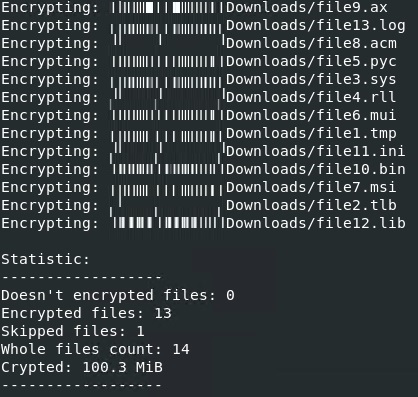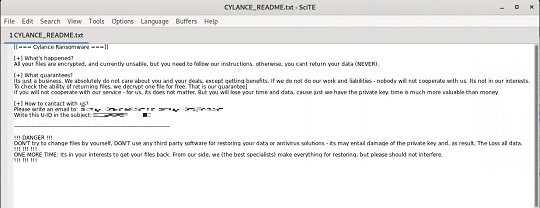Ransom.Linux.CELANCYC.THCCABC
Trojan.Ransom.Cylance.B (BITDEFENDER), Ransom:Linux/Babuk.E!MTB (BABUK)
Linux


Threat Type: Ransomware
Destructiveness: No
Encrypted: No
In the wild: Yes
OVERVIEW
This Ransomware arrives on a system as a file dropped by other malware or as a file downloaded unknowingly by users when visiting malicious sites.
It drops files as ransom note.
TECHNICAL DETAILS
Arrival Details
This Ransomware arrives on a system as a file dropped by other malware or as a file downloaded unknowingly by users when visiting malicious sites.
Other Details
This Ransomware does the following:
- It creates a specified number of threads depending on the number of processors of the infected machine.
- It displays the following if no parameter is provided:

- It displays the following on the terminal when encrypting files:

It accepts the following parameters:
- {path to encrypt} → required to proceed to its encryption routine
Ransomware Routine
This Ransomware avoids encrypting files with the following strings in their file name:
- CYLANCE_README.txt
- .Cylance
It appends the following extension to the file name of the encrypted files:
- {Original File Name}.{Original File Extension}.Cylance
It drops the following file(s) as ransom note:
- CYLANCE_README.txt

SOLUTION
Step 1
Trend Micro Predictive Machine Learning detects and blocks malware at the first sign of its existence, before it executes on your system. When enabled, your Trend Micro product detects this malware under the following machine learning name:
- Troj.ELF.TRX.XXELFC1DFF028
Step 2
Scan your computer with your Trend Micro product to delete files detected as Ransom.Linux.CELANCYC.THCCABC. If the detected files have already been cleaned, deleted, or quarantined by your Trend Micro product, no further step is required. You may opt to simply delete the quarantined files. Please check the following Trend Micro Support pages for more information:
Did this description help? Tell us how we did.

